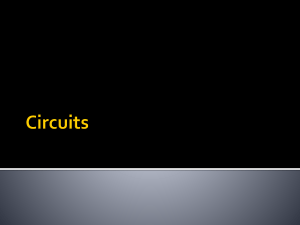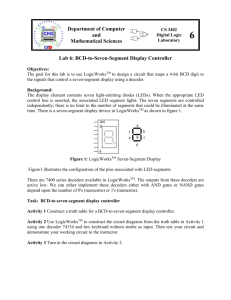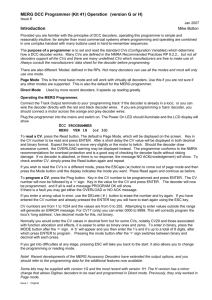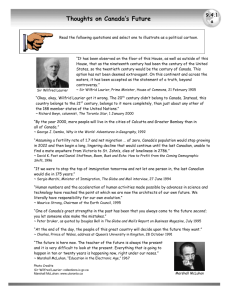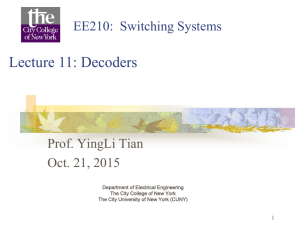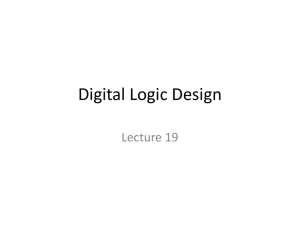Decoders Wilfrid Laurier University Terry Sturtevant January 27, 2012
advertisement
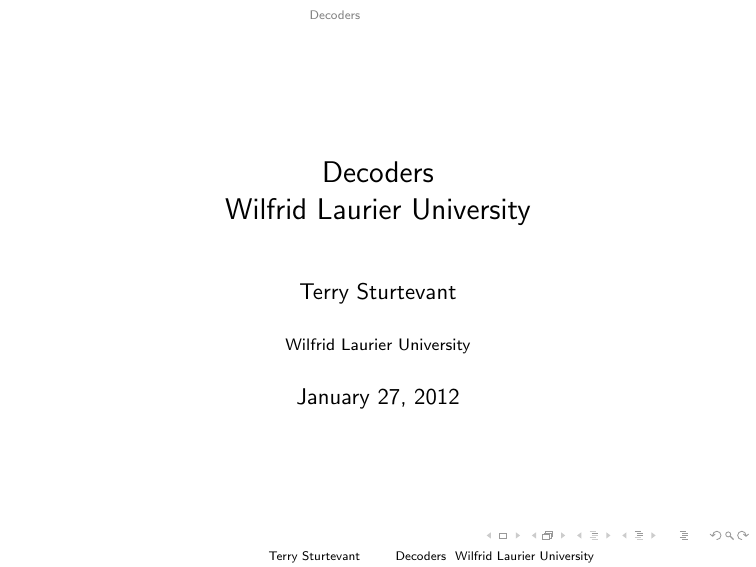
Decoders Decoders Wilfrid Laurier University Terry Sturtevant Wilfrid Laurier University January 27, 2012 Terry Sturtevant Decoders Wilfrid Laurier University Decoders Introduction 7 Segment Decoder Introduction Terry Sturtevant Decoders Wilfrid Laurier University Decoders Introduction 7 Segment Decoder Introduction A decoder usually converts one type of input pattern into a corresponding output pattern. Terry Sturtevant Decoders Wilfrid Laurier University Decoders Introduction 7 Segment Decoder Introduction A decoder usually converts one type of input pattern into a corresponding output pattern. In principle, virtually any combinational logic circuit could be thought of as some kind of “decoder”. Terry Sturtevant Decoders Wilfrid Laurier University Decoders Introduction 7 Segment Decoder O7 I3 O6 I2 O5 O4 I1 O3 I0 O2 O1 Here’s a generic decoder. Terry Sturtevant Decoders Wilfrid Laurier University Decoders Introduction 7 Segment Decoder 7 Segment Decoder Terry Sturtevant Decoders Wilfrid Laurier University Decoders Introduction 7 Segment Decoder 7 Segment Decoder A common type of decoder is used to take a numeric input, and produce outputs which will drive some sort of display. Terry Sturtevant Decoders Wilfrid Laurier University Decoders Introduction 7 Segment Decoder 7 Segment Decoder A common type of decoder is used to take a numeric input, and produce outputs which will drive some sort of display. A binary coded decimal, or BCD number, is simply a four bit value representing numbers from 0 to 9. Terry Sturtevant Decoders Wilfrid Laurier University Decoders Introduction 7 Segment Decoder 7 Segment Decoder A common type of decoder is used to take a numeric input, and produce outputs which will drive some sort of display. A binary coded decimal, or BCD number, is simply a four bit value representing numbers from 0 to 9. (It’s the same as hexadecimal, except that the combinations from A to F are not valid.) Terry Sturtevant Decoders Wilfrid Laurier University Decoders Introduction 7 Segment Decoder 7 Segment Decoder A common type of decoder is used to take a numeric input, and produce outputs which will drive some sort of display. A binary coded decimal, or BCD number, is simply a four bit value representing numbers from 0 to 9. (It’s the same as hexadecimal, except that the combinations from A to F are not valid.) A 7 segment display uses 7 LEDs in the shape of the number 8 to show any digit from 0 to 9, depending on which segments are lit. Terry Sturtevant Decoders Wilfrid Laurier University Decoders Introduction 7 Segment Decoder 7 Segment Decoder A common type of decoder is used to take a numeric input, and produce outputs which will drive some sort of display. A binary coded decimal, or BCD number, is simply a four bit value representing numbers from 0 to 9. (It’s the same as hexadecimal, except that the combinations from A to F are not valid.) A 7 segment display uses 7 LEDs in the shape of the number 8 to show any digit from 0 to 9, depending on which segments are lit. BCD to 7 segment conversion is a good example of the use of a decoder. Terry Sturtevant Decoders Wilfrid Laurier University Decoders Introduction 7 Segment Decoder b I3 a I2 f g I1 e I0 d c Here’s a BCD to 7 segment decoder, shown with a 7 segment display. Terry Sturtevant Decoders Wilfrid Laurier University Decoders Introduction 7 Segment Decoder b I3 a I2 f g I1 e I0 d c Operation for the input number 0 Terry Sturtevant Decoders Wilfrid Laurier University Decoders Introduction 7 Segment Decoder b I3 a I2 f g I1 e I0 d c Operation for the input number 1 Terry Sturtevant Decoders Wilfrid Laurier University Decoders Introduction 7 Segment Decoder b I3 a I2 f g I1 e I0 d c Operation for the input number 2 Terry Sturtevant Decoders Wilfrid Laurier University Decoders Introduction 7 Segment Decoder b I3 a I2 f g I1 e I0 d c Operation for the input number 3 Terry Sturtevant Decoders Wilfrid Laurier University Decoders Introduction 7 Segment Decoder b I3 a I2 f g I1 e I0 d c Operation for the input number 4 Terry Sturtevant Decoders Wilfrid Laurier University Decoders Introduction 7 Segment Decoder b I3 a I2 f g I1 e I0 d c Operation for the input number 5 Terry Sturtevant Decoders Wilfrid Laurier University Decoders Introduction 7 Segment Decoder b I3 a I2 f g I1 e I0 d c Operation for the input number 6 Terry Sturtevant Decoders Wilfrid Laurier University Decoders Introduction 7 Segment Decoder b I3 a I2 f g I1 e I0 d c Operation for the input number 7 Terry Sturtevant Decoders Wilfrid Laurier University Decoders Introduction 7 Segment Decoder b I3 a I2 f g I1 e I0 d c Operation for the input number 8 Terry Sturtevant Decoders Wilfrid Laurier University Decoders Introduction 7 Segment Decoder b I3 a I2 f g I1 e I0 d c Operation for the input number 9 Terry Sturtevant Decoders Wilfrid Laurier University Decoders Introduction 7 Segment Decoder For a BCD to 7 segment decoder, hexadecimal inputs from A to F are not valid, so the behaviour in this example has not been specified. Terry Sturtevant Decoders Wilfrid Laurier University Decoders Introduction 7 Segment Decoder For a BCD to 7 segment decoder, hexadecimal inputs from A to F are not valid, so the behaviour in this example has not been specified. There may be additional inputs on a decoder such as this to do things like turn all of the segments on or off for testing purposes. Terry Sturtevant Decoders Wilfrid Laurier University
